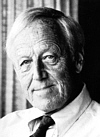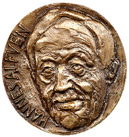

Hannes Alfvén, Nobel Laureate for Physics and Honorary Member of the European
Geophysical Society, died 2 April 1995 in his home in Djursholm, Sweden.
Born on 30 May 1908 in Norrköping, Sweden, Hannes Alfvén had a swift academic career
marked by doctorate at age 26 and appointment as full professor at the Royal Institute of
Technology at age 32.
As professor he gathered around him a growing number of scientists, engineers and
students, to whom he was an exceptionally inspiring and generous leader, spreading
fruitful ideas around him without any claim to co-authorship of publications deriving from
them. His vigorous scientific activity led to a rapid expansion and to the creation
of a number of new professorships and departments. The three departments that most
directly trace their origin to his work now form a separate entity within the Royal
Institute of Technology, the Alfvén Laboratory, founded in 1990.
In 1967 Hannes Alfvén accepted a professorship at the University of California, San
Diego. But every year he spent the time "from the Vernal Equinox until the
Autumnal Equinox" in Sweden in very active scientific interaction with his colleagues
at the Royal Institute of Technology. His annual return was always something to look
forward to.
Already at a young age Hannes Alfvén had become interested in cosmical physics. As
a graduate student he developed a theory of the origin of cosmic radiation, published in
Nature in 1933. This paper, like all his subsequent work, was based on the principle
that theories of cosmical phenomena must agree with results from laboratory experiments on
Earth, because the same laws of Nature should apply everywhere.
His work on the cosmic ray problem led him to proposing, already in 1937, that there
exists a galactic magnetic field. This proposal was generally dismissed,
and only much later was the existence of the galactic magnetic field confirmed, apparently
without recognition of Hannes Alfvén's original proposal.
All of Hannes Alfvén's scientific work reveals a profound physical insight and an
astounding intuition, which allowed him to extract results of great importance and
generality from specific problems, and to do so by physical reasoning and with only a
minimum of mathematics. Another key to his success seems to be the fresh perspective
that he got by approaching astrophysical problems from an electromagnetic point of view, a
fruit of his youthful fascination with electronics as well as astronomy. In fact,
when his book Cosmical Electrodynamics was published in 1950, the author was in one
review, written by T.G. Cowling, referred to as an "electrical engineer in
Stockholm".
His most well-known discovery, of what we now call Alfvén waves, is in many ways
typical of his approach. It grew out of a specific problem, namely that of sunspots
and the sunspot cycle, but the waves he discovered have proved to be of fundamental
importance in all of plasma physics and its applications.
He formulated his discovery in an admirably simple and clear mathematical form in a Letter
to Nature published in 1942 (Existence of Electromagnetic-Hydrodynamic Waves, Nature, 150,
405-406, 1942).
Incredible as it may seem to us today, it took years before this discovery was taken
seriously. Some of his critics maintained that if such waves existed, Maxwell would
have discovered them. As Hannes Alfvén tells it, the breakthrough came in 1948,
when after a seminar by Hannes in Chicago, Enrico Fermi said "of course such waves
could exist", and again according to Hannes Alfvén's own account, the prestige of
Enrico Fermi was such that "the next day every physicist said 'of course"'.
Closely related to the Alfvén waves is the concept of frozen-in magnetic field lines.
This concept greatly simplifies physical reasoning about many plasma physical
problems and has come to be widely used but perhaps not always recognized as due to Alfvén.
Turning his attention to the Earth's magnetic field and the phenomenon of the aurora he
found the established way of calculating particle orbits to be impractical, especially in
the energy range relevant to auroras. He therefore developed, as a tool, the gyro
center approximation for the motion of charged particles in electric and magnetic
fields. This approximation, and its further development into the adiabatic theory of
particle motion, has come to be an invaluable tool throughout the field of plasma physics.
Using his gyro center approximation he developed the concept of a ring
current in the Earth's magnetic field, now a well-known feature of the magnetosphere.
One of Hannes Alfvén's most daring ideas was the concept of a critical
velocity in plasma neutral-gas interaction, which was met with disbelief but later
observed both in the laboratory and in space. Almost as daring was the suggestion,
in 1958, that magnetic-field aligned electric fields, perhaps in structures
called electric double layers, exist above the ionosphere and cause the downward
acceleration of auroral primary electrons. This concept, too, was initially
discarded but brought to prominence later as a result of measurements in space.
In 1970 Hannes Alfvén was awarded the Nobel Prize for Physics for "his contributions
and fundamental discoveries in magnetohydrodynamics and their fruitful applications in
different areas of plasma physics". In addition to the Nobel Prize Hannes Alfvén
has received many other honours, including the Bowie medal of the AGU, and he was one of
the few who were members of both the American and the Soviet Academies of science.
Hannes Alfvén has, together with his wife Kerstin, taken an active interest also in
important matters outside science, especially matters related to environment, population
growth and disarmament. During several years in the 1970's he was President of the
Pugwash movement. This is an activity initiated by Albert Einstein and Bertrand
Russell and named after a small Canadian fishing village, where the first meeting was held
and where the Einstein-Russell Manifesto was generated. In this movement, eminent
scientists from both of the superpowers as well as Western Europe, Japan and the third
world meet annually, not as representatives of their countries but as concemed
individuals.
Hannes Alfvén has contributed to the progress of science not only by his own work but
also by the extraordinary inspiration that he has given to his many students as well as to
colleagues all over the world. His passing has left his many friends with a feeling
of great loss but also of deep gratitude for all that he has meant as a scientist and as a
friend.
Carl-Gunne Fälthammer